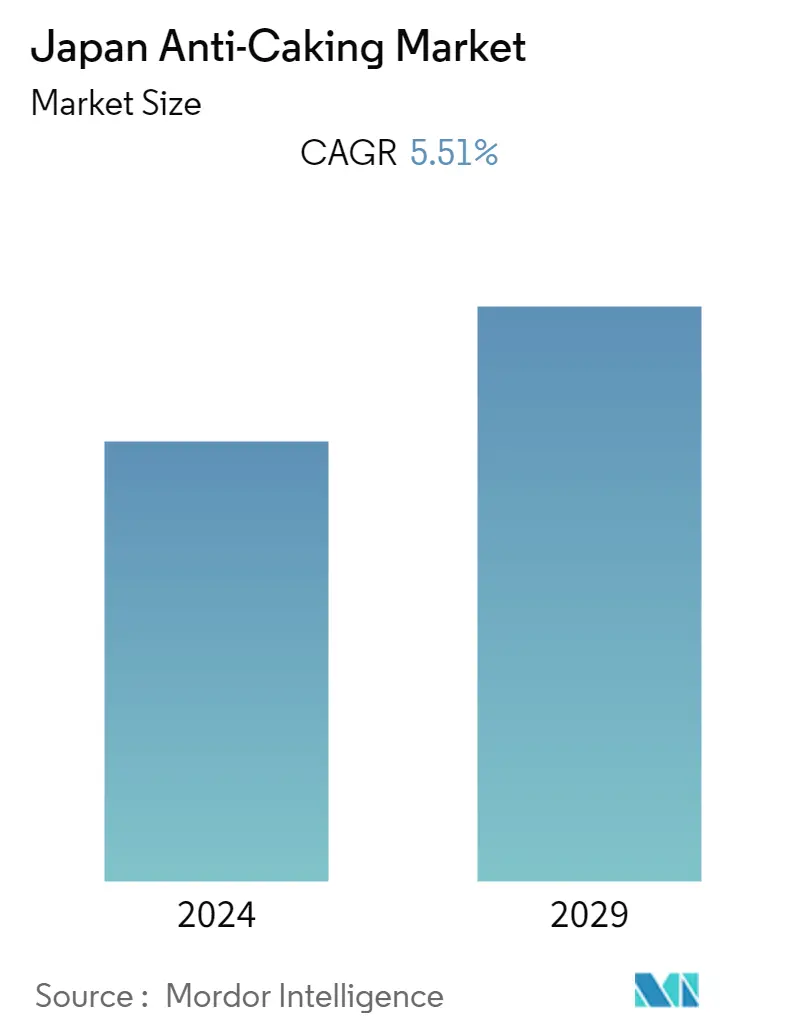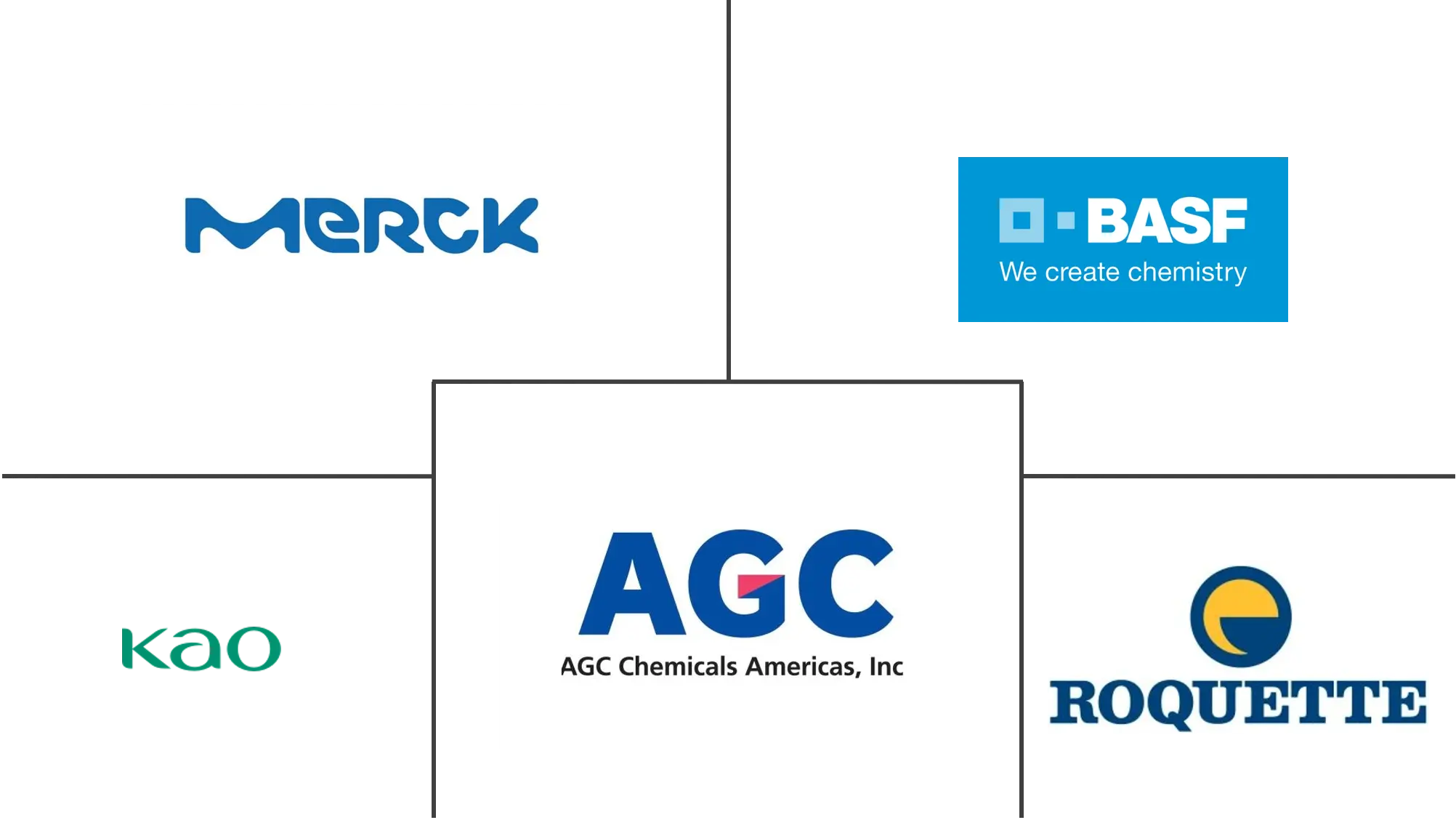Market Size of Japan Anti-Caking Industry

| Study Period | 2019 - 2029 |
| Base Year For Estimation | 2023 |
| Forecast Data Period | 2024 - 2029 |
| Historical Data Period | 2019 - 2022 |
| CAGR | 5.51 % |
| Market Concentration | Low |
Major Players
*Disclaimer: Major Players sorted in no particular order |
Japan Anti-Caking Market Analysis
The Japanese anti-caking market is projected to witness a CAGR of 5.51% during the forecast period, 2020 - 2025.
- Robust consumer market persisting in Japan has been a primary reason boosting the additives market in the country, including the sale of anti-caking agents. The availability of raw materials and the new technological advancements are other factors resulting in the growth of the anti-caking agent market in the country.
- Manufacturers, in order to prevent the formation of lumps in powdered products, across the applications, like detergents, coffee, cement, feed, etc., are incorporating anti-caking agents, during formulations. This is leading to an increased demand for the market studied in the country.
Japan Anti-Caking Industry Segmentation
The Japanese anti-caking market is segmented into calcium compounds, sodium compounds, magnesium compounds, and others. The study also includes revenue generated through food and beverage, cosmetic and personal care, feed, and others.
| Type | |
| Calcium Compounds | |
| Sodium Compounds | |
| Magnesium Compounds | |
| Other Types |
| Application | |||||||
| |||||||
| Cosmetic and Personal Care | |||||||
| Feed | |||||||
| Other Applications |
Japan Anti-Caking Market Size Summary
The Japanese anti-caking market is experiencing significant growth, driven by a robust consumer base and advancements in technology. The availability of raw materials has further bolstered the market, as manufacturers incorporate anti-caking agents to prevent lump formation in various applications such as detergents, coffee, cement, and animal feed. This increasing demand is also fueled by the need for anti-caking agents in food products like coffee, cocoa, and baking powders, which are essential for maintaining product quality and consistency. The market is poised for expansion, with opportunities emerging from the Asia-Pacific region due to rising disposable incomes and a growing appetite for processed foods and beverages.
In the Japanese market, calcium compounds play a crucial role as anti-caking agents, with substances like calcium silicate and calcium phosphate tribasic being widely used to absorb moisture and enhance product stability. Leading companies such as Evonik Industries AG, Merck KGaA, and Kao Corp are investing in new production facilities to meet the increasing demand. However, the high cost of natural anti-caking agents presents a challenge, prompting manufacturers to focus on technological innovations in this area. The Japanese food industry, while saturated, is exploring opportunities in East Asian markets by adapting to local food practices and regulations, further driving the demand for anti-caking agents.
Japan Anti-Caking Market Size - Table of Contents
-
1. MARKET DYNAMICS
-
1.1 Market Drivers
-
1.2 Market Restraints
-
1.3 Industry Attractiveness - Porter's Five Forces Analysis
-
1.3.1 Threat of New Entrants
-
1.3.2 Bargaining Power of Buyers/Consumers
-
1.3.3 Bargaining Power of Suppliers
-
1.3.4 Threat of Substitute Products
-
1.3.5 Intensity of Competitive Rivalry
-
-
-
2. MARKET SEGMENTATION
-
2.1 Type
-
2.1.1 Calcium Compounds
-
2.1.2 Sodium Compounds
-
2.1.3 Magnesium Compounds
-
2.1.4 Other Types
-
-
2.2 Application
-
2.2.1 Food and Beverage
-
2.2.1.1 Bakery Products
-
2.2.1.2 Dairy Products
-
2.2.1.3 Soups and Sauces
-
2.2.1.4 Beverage
-
2.2.1.5 Other Food and Beverage
-
-
2.2.2 Cosmetic and Personal Care
-
2.2.3 Feed
-
2.2.4 Other Applications
-
-
Japan Anti-Caking Market Size FAQs
What is the current Japan Anti-Caking Market size?
The Japan Anti-Caking Market is projected to register a CAGR of 5.51% during the forecast period (2024-2029)
Who are the key players in Japan Anti-Caking Market?
Merck KGaA, BASF SE , Kao Corporation and Roquette Frères are the major companies operating in the Japan Anti-Caking Market.

